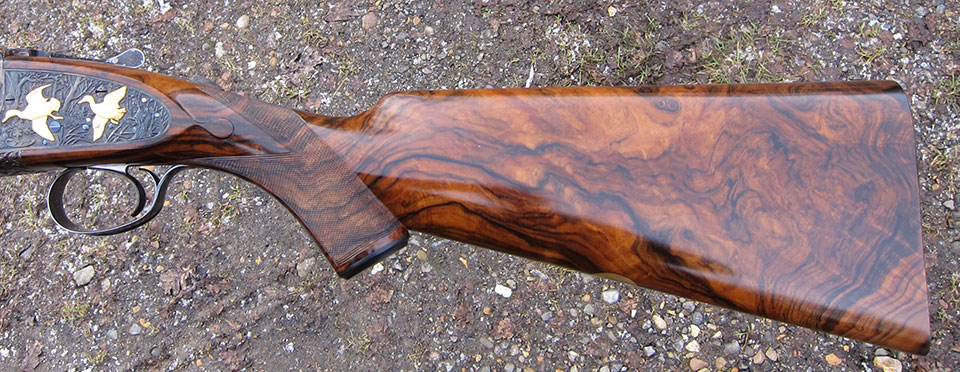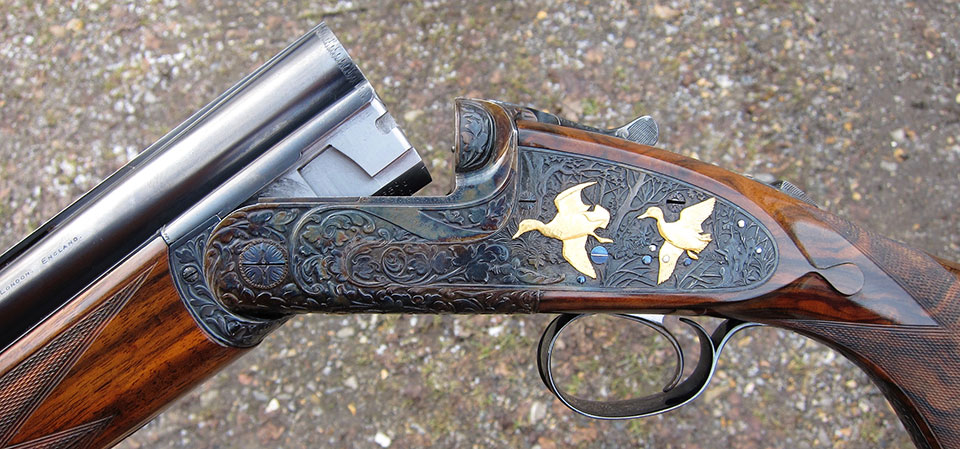The 1970s may be remembered for hostesses in lime-green, nylon, trouser-suits and The Brotherhood of Man warbling on the turntable, while dinner guests sipped a tepid glass of Blue Nun or swilled Watneys Red Barrel from tankards and got foam on their ridiculous moustaches.
However, in the British Gun Trade, times were not so funny. Most businesses suffered from problems that could well have killed them off, indeed which did kill many of them off. Many of the guns from the era live on to tell the sad story of cost-cutting, inflation and decline; the issues facing the economy visible in the wood and metal of the guns themselves.
The ‘70s can’t take all the blame. The problems that came to a head in the 1970s had started in the 1930s, when the Great Depression, kicked off by the Wall Street Crash of 1929 killed off demand for consumer items in general, and the sporting gun market was no different. Even the most famous firms, like Purdey and Holland & Holland were reducing staff and cutting the working week in order to stay afloat. The Depression was followed, fairly quickly, by WW2; in 1939. Many gunmakers were seconded to help the war effort and other industries and some never returned. The great days of continuity of service and jobs for life in the trade were numbered.

The enforced period of austerity that followed Hitler’s demise saw restrictions in the availability of many materials, such as steel, to civilian industries. Gun-making was seen as a ‘luxury’ so it did not get priority even when these materials were available. To add to the problems, demand for guns and rifles dropped as the Empire began to shrink rapidly and the policies of the Labour government, aimed at redistributing wealth, resulted in many big country estates being split, the big houses demolished and the traditional fabric of sporting society face serious setbacks in Britain.
Interestingly, the quality of many guns from the 1930s and 1940s is fabulous, production numbers may have fallen but quality did not, it seems. We must remember that the men working in the factories during these years were remnants of the generation of gunmakers who had seen the development of the breech-loader from inception into its final form; they were apprenticed under the acknowledged masters and their skills were second to none. By the1950s, that generation was retiring. In the 1960s, Birmingham redevelopment devastated the Gun Quarter and some iconic factories were compulsory purchased and demolished.
We cannot, however, blame the men at the bench entirely for the poor reputation of 1970s guns, the management of the firms responsible had to steer a course through a terrible economic period that, in reality, stretched from 1973 to the mid 1980s. During this period of high inflation, high unemployment and general economic malaise, culminating in the ‘Winter of Discontent’, in 1979, the gun trade in Britain was decimated. Thatcher attacked the twin terrors of inflation and strikes but unemployment remained high until Tony Blair’s government was elected, in 1997.
Of all these issues, perhaps inflation was the one that the trade dealt with worst. With build times counted in years, by the time a gun was delivered, it had cost more to make than the customer had paid when he ordered it. There were tales of customers collecting a newly made gun and selling it immediately for twice what they paid, as the cost had risen so much in the interim. One can only imagine what pressure there was to reduce costs as much as possible.
One engraver said recently that the pressure to finish work in limited time and keep the bill to a minimum was intense, not helped, he admitted by lunchtime libations in the nearest pub. The time allowed to engrave a Holland & Holland ‘Royal’ in 1971 was 70 hours, using just a push-graver, and a sandbag for support. However, production times between order and delivery in this period were outrageous, some guns taking a full decade to reach the hands of the customer.

Among the quality issues that are observable in guns of the period, as well as the, often hurried looking engraving, is a general coarseness in overall impression. They lack the indefinable grace of a gun that has been lovingly constructed. A really fine gun is more than the sum of its parts but a poorly constructed gun, one in which each stage has been rushed, inevitably adds up to an unhappily concluded object. To add to the difficulty we have in learning to love these guns, there was something going on with the quality of steel being used by many in the trade. While serviceable enough, the tell-tale sign of the times is a reddish hue to the blacking of barrels and furniture. For some reason it blacks normally but quickly changes to an almost plum colour.
Fashion is also a factor working against the guns under discussion. A Purdey over & under with two sets of 28” barrels? There is nothing wrong with 28” barrels and in the 1970s they were the preferred length; even 26” was not uncommon. Today, nine out of ten customers specify 30” tubes. That makes selling ‘70s guns difficult, even if they are little used and in very good condition. Ken Hunt, many argue saved the gun trade in the seventies by transforming guns with his engraving, which became very collectable. But even the best engraving styles of the era now look dated and are somewhat out of favour.
The pressure on British gunmakers from 1970 to 1985 was intense and many not only failed to hold their previously high standards of production, they went out of the business of making guns altogether. Consider some of those names: Churchill, Atkin, Grant, Lang, Cogswell & Harrison, Thomas Bland, John Dickson, W.W Greener, William Evans. Happily, some have been resurrected since but, at the time, it seemed as though decline and fall were irreversible and inevitable consequences of the economic climate.
However, poor as the reputation is for guns of this age, of we must remember that some of today’s most revered gunmakers plied their trade in the 1970’s. David Mitchell, David Sinnerton, Richard Tandy, Ken Hunt and David Dryhurst, to name but a handful. One ex-Purdey finisher commented, when I broached the subject, that he thought the best gunmakers from any era would compare favourably with one another. The really talented and dedicated craftsmen, who take pride in their work, have survived and carried their legacy into the present day, they have inspired the new generation of gunmakers and engravers, the best of whom are producing some really top class work.
From a collector’s viewpoint, guns of the ‘70s are not the connoisseur’s choice but they can be good value to the man who wants to shoot a lot and not pay top dollar for his Purdey many of these guns are chambered for 2 3/4” cartridges and have not seen much use. I recently sold a 1977 Purdey with single trigger and two sets of barrels, cased and in almost unused condition, for £10,000 less than the same gun built in 1935 would have cost.

Published by Vintage Guns Ltd on




